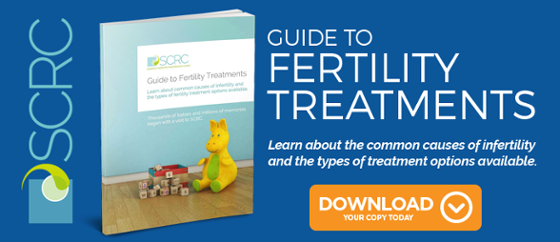
Past and present sexual health can play an important role in fertility. Some sexually transmitted diseases (STDs) can leave scarring and inflammation which make it more difficult to conceive, even after the infection has been treated.
For women, this scarring usually occurs as a side effect of Pelvic Inflammatory Disease (PID) which develops as a secondary infection after contracting an STD. Having an active STD while pregnant may also have consequences for the health of the baby. Increasingly, the term STD is being replaced with STI, or sexually transmitted infection. This is to underline that many people can be infected without showing symptoms or developing a disease. Someone with an asymptomatic STI may still be at risk of passing on the infection to a partner or baby, or may eventually develop symptoms later.
Discussing your sexual health status can be uncomfortable, but it is an essential part of planning for a baby. The good news is that if you do have a history of a sexually transmitted infection, there are treatments which can help. Understanding how an STI can affect your fertility and what to do about it is important for any patient who wants to get pregnant after an STI.
Here is a look at some of the STDs, their potential impact on fertility and how you and your doctors can overcome fertility challenges and minimize risk before you get pregnant.
Human Papillomavirus (HPV)
HPV, also known as genital warts, is an extremely common STI: almost 80 million people in the US have some form of HPV with another 14 million being infected each year. By some estimations, almost 75% of sexually active men and women in the US are affected by HPV. There are more than 100 different strains of HPV, with only 40 of those being sexually transmitted. Of those 40, only a few have the potential to cause visible genital warts. An even smaller percentage of HPV strains are dangerous with the potential to cause cancer. There is no medical cure for HPV but fortunately for most people, HPV is asymptomatic, and their bodies clear the infection on their own fairly quickly, within a few months to two years.
Most fertility issues arise when you are infected with one of the cancer-causing strains of HPV. Some women will develop pre-cancerous cells on their cervix which must be removed by a medical procedure. There are three techniques used to remove these cells.
- A cone biopsy is when a portion of the cervix is removed.
- Cryosurgery freezes and destroys abnormal tissue.
- Loop Electrosurgical Excision Procedure (LEEP) removes precancerous cells and superficial cervical tissue with an electrically charged wire loop.
All of these procedures carry the risk of making it more difficult to get pregnant or carry a baby to term if you do get pregnant. They may change or reduce cervical mucus, which makes it more difficult for sperm to reach the egg. This could also weaken your cervix, causing a condition known as cervical insufficiency or cervical incompetence, which can cause miscarriage or premature birth if your cervix opens while you are pregnant.
What can be done?
- IUI or IVF: If HPV treatment has caused a problem with your cervical mucus which is making it difficult to conceive, intrauterine insemination or in vitro fertilization can be good options, as they bypass the area altogether.
- Cervical monitoring: If you or your doctor are concerned about cervical insufficiency due to treatment for precancerous cells, you will be monitored very carefully during your pregnancy. Transvaginal scans are a type of ultrasound performed with a wand inserted into the vagina which can help doctors check the length of the cervix. Special vaginal swabs can also check for markers that indicate a risk of preterm birth. If signs of weakness are detected, you may be treated with supplemental progesterone, bedrest, and/or a procedure called a “cervical stitch” or cerclage, which can help keep your cervix closed for longer.
- Cesarean section: If you have active HPV warts while pregnant, pregnancy hormones can cause the warts to grow faster. If they are blocking the birth canal your doctor may recommend a C-section. This can also minimize the chance that your baby will come into contact with the virus during birth: in rare cases such exposure can lead to the baby developing warts on their vocal chords.
Genital Herpes
Genital herpes is another common STI, usually caused by the Herpes Simplex Virus type 2 (HSV-2), though HSV-1, which is known as oral herpes and causes cold sores, can also be transmitted to the genitals. Herpes usually causes painful sores on the genitals during an outbreak. Almost one in four women in the USA has been infected by HSV-2, compared to one in eight men. There is no cure for genital herpes, although outbreaks can usually be well-contained with medication. It does not affect your ability to conceive, but it does pose risks to the baby. In very rare cases, if the virus is present in the birth canal, it can be passed onto the infant, causing neonatal herpes, a potentially deadly infection.
The vast majority of women with genital herpes do not pass the infection onto their babies: less than 0.1% of babies born in the US each year contract neonatal herpes. The biggest risk of transmission happens when the mother acquires a genital herpes infection late in her pregnancy. This means that her body may not have time to create the antibodies which would normally be passed on to the baby. Women who contracted herpes before getting pregnant have a very low risk of transmitting the virus: antibodies from their immune system will cross the placenta and offer temporary protection during birth.
What can be done?
- Antiviral medication: Drugs such as Zovirax (acyclovir) or Valtrex (valacyclovir) can be taken during pregnancy, particularly in the last trimester or weeks, to cut down the chance of an outbreak before delivery. There is no evidence of these medications causing serious side effects in babies whose mothers were treated during pregnancy.
- Precautions in the delivery room: Your birth team can examine the birth canal in early labor for any signs of herpes lesions. They can avoid puncturing the bag of water, which may help to protect the baby from the virus. They can also use external monitors rather than scalp monitors for the baby and minimize the use of forceps or suction, all of which prevents creating tiny punctures in the baby’s scalp.
- Cesarean section: If your doctor feels there is significant risk of transmission during birth, they may recommend a C-section.
Chlamydia
Chlamydia is another very common sexually transmitted infection, with an estimated three million cases each year. Unlike HPV and herpes, however, chlamydia is not a virus but a bacterial infection. This is good news, because if caught early, it can usually be treated easily with antibiotics.
The trouble with chlamydia is that it is usually asymptomatic, so you could be carrying an untreated infection without knowing it. This is dangerous for several reasons. chlamydia is a serious cause of Pelvic Inflammatory Disease (PID) which leaves you at risk of inflammation, scarring, and blockage in your reproductive organs, particularly your fallopian tubes. This can make it difficult or impossible to get pregnant, because the sperm and egg are unable to meet. PID also puts you at risk for an ectopic pregnancy which can be deadly if the pregnancy is not removed in time. Untreated chlamydia can also cause serious health problems for a baby. About half of the babies born to mothers with untreated chlamydia infections contract pink eye. Also known as neonatal inclusion conjunctivitis when a newborn baby is affected, this infection causes swelling and the production of pus. If left untreated, it can cause corneal scarring.
Chlamydia in the male partner can also be a factor in a couple’s infertility, according to new research, though what role it plays is not yet understood.
What can be done?
- Antibiotics: If evidence of an active infection is found, a course of antibiotics will be ordered to clear the infection.
- Surgery: Blocked fallopian tubes or other pelvic scarring can sometimes be resolved with laparoscopic surgery.
- IVF: In vitro fertilization is often a very successful treatment for women who struggle to conceive because of a previous PID infection.
Gonorrhea
Approximately 820,000 cases of gonorrhea are reported in the US each year. Like chlamydia it is a bacterial infection which can usually be treated with antibiotics, though some strains are reportedly becoming resistant, which can make it more difficult to resolve. The risks of untreated infection are very similar to chlamydia as well: it is often asymptomatic, can cause PID and scarring, and can be passed on to a baby during birth. Similar to chlamydia, a baby infected with gonorrhea may develop pink eye: in this case it is called gonococcal conjunctivitis. Untreated, it can cause blindness.
Gonorrhea can also affect fertility in the male partner. The infection can result in a condition known as epididymitis, where the tube near the sperm ducts known as the epididymis becomes inflamed. When untreated, epididymitis can cause scarring which impacts the production and transport of sperm in the male body.
What can be done?
The treatments for gonorrhea and its related fertility problems are the same as chlamydia: antibiotics, surgery, or IVF.
Syphilis
Syphilis is a serious bacterial STI has unfortunately become more common in recent years. It is treatable with penicillin when it is detected at an early stage, but when undetected it can have tragic consequences. A woman who becomes pregnant while suffering from an untreated syphilis infection has a 50% chance of her pregnancy ending in miscarriage or stillbirth.
Unfortunately, syphilis is very easy to transmit to a baby at any stage during pregnancy (the infection can cross the placenta) or during childbirth. Congenital syphilis is extremely dangerous to a newborn baby, with a significant chance of fatality when untreated. Getting tested for syphilis before getting pregnant or early in the first trimester is extremely important: the symptoms are not always obvious. Fortunately, treatment with penicillin can help protect both mother and baby throughout the pregnancy and beyond. When detected and treated early, transmission rates drop to 1 or 2% from the 50% transmission rate among untreated mothers.
Untreated syphilis can cause infertility in both women and men. Later stages of the disease cause damage to organs and nerves, which can affect all the systems of the body, including the reproductive system. For men, epididymitis causes most syphilis-related infertility.
What can be done?
Penicillin: Penicillin is the only approved treatment for syphilis, to the point where patients with penicillin allergy often go through a desensitization process so that they can take the medication. For women with a history of syphilis, ongoing monitoring and testing of themselves and their baby before and after birth are key to catching signs of congenital syphilis.
HIV
Human Immunodeficiency Virus (HIV) doesn’t affect a woman’s ability to get pregnant, although if untreated HIV has progressed to AIDS, overall poor health and damage to internal organs can make sustaining a pregnancy very difficult. The main issue with HIV and pregnancy is preventing transmission from mother to baby. Knowing your HIV status before pregnancy is extremely important: with the right precautions, the risk of transmission can be lowered to about 1%.
What can be done?
HIV medications during pregnancy: Most HIV medications are safe to use while pregnant. By lowering the viral count (or how much HIV is present in the body) these medications can make it much less likely that HIV is passed through the placenta to the baby.
Cesarian section: In some cases, a scheduled C-section can help reduce the risk of transmission during delivery.
Not breastfeeding: HIV can be present in breast milk, so feeding the baby formula instead is important.
Postnatal medication for baby: Babies born to an HIV positive mother will take HIV medications for the first 6 to 8 weeks of life to help ensure that the virus does not have a chance to take hold in their systems.
When it comes to dealing with STIs and their impact on your fertility and the health of your future baby, knowledge is power. When you know your STI status, you and your medical practitioners can take steps to keep both you and your baby safe. Remember that you have a right to non-judgmental advice, guidance and treatment, and most problems of this type have a simple solution. If you think that a history of STI could be causing your fertility problems, don’t hesitate to speak to a doctor about it.
Share this on social media:





